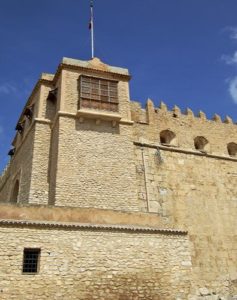El Kef is an important regional centre in the north of Tunisia near the Algerian border. The old town is perched on the flanks of Jebel Dyr mountain which rises dramatically from the plain. The new town sprawls below it.
The Kasbah dominates El Kef and can be seen from just about everywhere, with the golden coloured stone glowing in the sunlight. The best description of a Kasbah is a fortress. It has high walls and provides accommodation for the governor and barracks. All of the old major towns in Tunisia had a Kasbah, although many have now been demolished (Tunis) or turned into hotels (Kairouan).
The wall which originally surrounded the old town can be seen running up the hill behind the Kasbah to the Presidential Palace. The wall was demolished to build this for President Bourguiba and it occupies a prime spot in El Kef surrounded by large grounds. It is rarely used now.
El Kef has a long history as the area has been settled since neolithic times. The Carthaginians established a town here to protect the western fringe of their empire. It was annexed by the Romans, raided by the Vandals and captured by the Arabs in the 7thC. The Ottomans arrived in the 16thC and rebuilt the fortifications. It was the first town to be occupied by the French in 1881 and was the provisional capital of Tunisia during WW2.
The Kasbah is actually made up of two forts. The Grand Fort was originally built by the Byzantines in the 6thC and was reinforced by the Turks in the 16thC. To the south west of it is the Petit Fort which was added later and is now closed and in poor condition. There is no access to the fort but it is possible to walk down the side to admire the stable block. There is talk of turning the stables into a cafe and the fort into a hotel.
There is limited parking on the road leading up to the Kasbah. Entry is through a large wooden gateway. On one side is a grassy bank with cannons and the wall of the Kasbah on the other side. The remains of the Petit Fort are ahead. The road climbs past the remains of the prison block to the Grand Fort, which has been restored. This has two entries. The older one on the right is smaller and crosses a drawbridge with a right angle turn through a barbican into the fort. To the left is a larger entrance made by the French which gave easier entrance directly into the courtyard. Above the entrance were the Governor’s quarters.
The courtyard is a large open square lined with rooms which served as barracks and the garrison for the army. There are large bastions at the corners and steps and ramps lead to the walkway round the top. This has good views down on the 6thC Basillica and 17thC Zaouia and Mosque of Sisi Bou Makhlouf. Further along the ramparts there are views across the town to the remains of the Roman baths and cisterns.
We were approached by a young Tunisian girl who said she was an official guide and offered to give us a tour of the Kasbah. Unusual for Tunisia, this was free. She had limited English so our driver acted as interpreter for us as we asked all our questions questions.
Interesting but there isn’t a lot to see.








